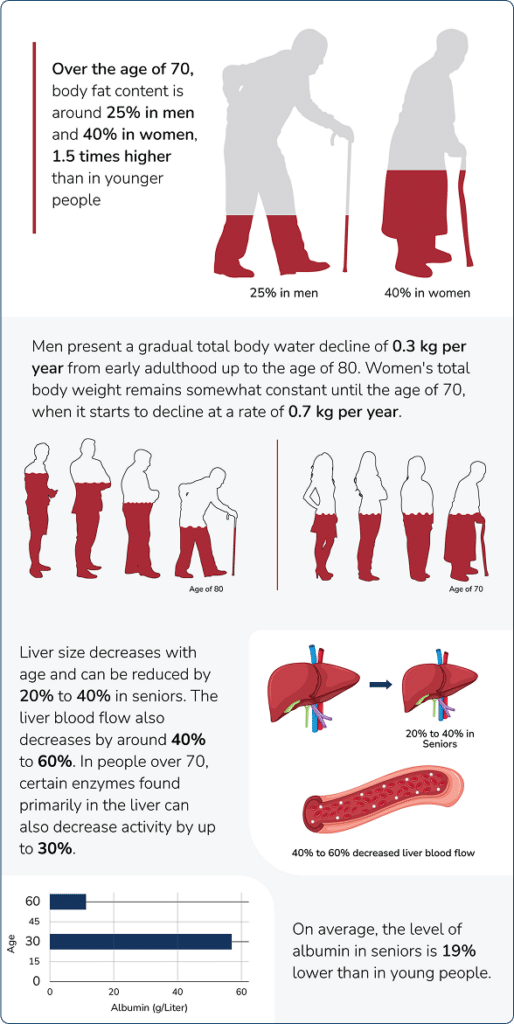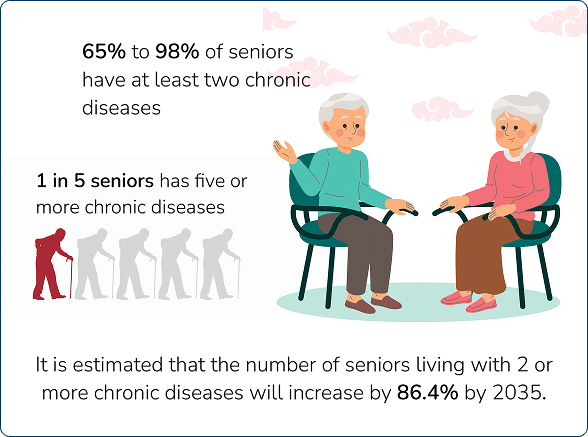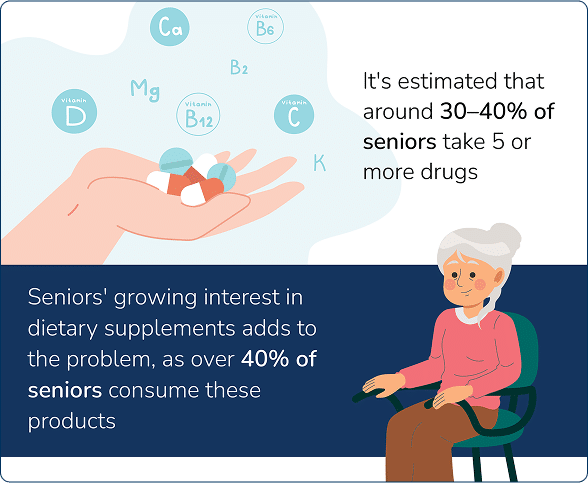A Guide to Dangerous Drug Interactions in Seniors
Older Americans often use five or more different medications to treat multiple long-term conditions, making them more vulnerable to negative drug-drug interactions, or DDIs. Our guide can help you understand, identify, and prevent negative drug interactions for you and your loved ones.
The United States has one of the world’s highest rates of medication use, with at least one in 25 older adults—roughly 2.2 million people—taking multiple prescription drugs.
However, while a University of Michigan study found that 90 percent of older adults were confident they could avoid harmful drug interactions, only 35 percent of those respondents had actually discussed the topic with a medical professional.
Drug-drug interactions, or DDIs, can occur in as much as 90 percent of cases in geriatric units. The likelihood of dangerous interactions varies based on patients’ conditions and their care complexity.
The Lanier Law Firm has created this guide to help older adults understand the risks of dangerous drug interactions and learn how to avoid unintended consequences. If you or a loved one has been harmed by a drug interaction, contact us online today for a free consultation.
Why Are Seniors Often at Risk for a Drug-Drug Interaction?

Drug interactions are more common among seniors because the following are the three main risk factors for DDIs:
- Advanced age
- Multiple morbidity, or having two or more long-term health conditions
- Polypharmacy, or regularly using five or more prescription drugs at the same time
The coexistence of all three factors makes older adults both more prone to higher rates of drug interactions and more vulnerable to the negative effects.
The Link Between a Senior’s Metabolism and the Drugs They Take
As people age, they undergo physiological changes affecting their bodies’ processing of different drugs. These changes include the following:
- Increased body fat affects how fat-soluble drugs are distributed.
- Decreased body water & muscle mass alter how water-soluble drugs are absorbed.
- Declining kidney and liver function, which slows the rate at which drugs are processed through the body, raises the risk of accumulation and side effects.
- Lower levels of albumin, a key protein that moves substances through the bloodstream, lead to higher levels of free drug concentrations and increased risk of toxicity.
- Changes in drug sensitivity, especially in nervous system depressants like opioids and benzodiazepines, occur over time.
These changes make older adults more vulnerable to drug interactions and adverse effects. Avoiding unintended DDIs requires careful dosing and monitoring to ensure you’re receiving the correct amount of medication for your body.

The Co-Occurrence of Multiple Diseases in the Elderly
As part of the natural process of human aging, older adults often develop multiple chronic illnesses over the course of their lives. Multimorbidity can often lead to polypharmacy, raising the risk of adverse effects and DDIs between 5 or more active medications.
Some overlapping conditions, such as heart disease, diabetes, and kidney disease, can make drug dosing more difficult by interacting with each other and with other medications. Older adults are more likely to experience side effects, reduced drug effectiveness, or toxicity when managing multiple diseases.
Studies suggest that more than two-thirds of older adults said they see multiple doctors, and some also use multiple pharmacies. The more medical providers involved in a single person’s care, the more likely prescriptions will overlap or have unnoticed negative interactions. It’s important to ensure your health care providers are all aware of each medication you take to avoid any preventable consequences.


The Long-Term Use of Multiple Drugs
Adults aged 65 or older account for more than one-third of all spending on outpatient prescription medications in the U.S., despite only making up roughly 14 percent of the population. The sheer number of medications most older adults take creates more opportunities for unintended interactions or negative side effects.
A recent spike in the popularity of dietary supplements has also increased the potential for DDIs in older adults. According to a study from the University of Chicago Medicine, 68 percent of adults who took prescription drugs were also using over-the-counter medicines or supplements. Men were more likely to use OTC medicines, while women were more likely to use supplements.
Some recent studies have found that excipients—additives generally considered to be inert—may influence the effectiveness of certain drugs.
What Are the Common Drug Interactions in the Elderly?
Several prominent medications have known interactions that can create negative side effects in older adults. Examples of common DDIs include:
1. Benzodiazepines and Opioids

During the first few days and weeks that follow the accident, your child may experience acute stress disorder, a form of emotional distress with symptoms that are similar to PTSD, such as intrusive thoughts, difficulty concentrating, nightmares, and flashbacks.
If symptoms last longer than a month, your child may have PTSD. As the child grows older and develops more complex thinking skills, the symptoms and thinking patterns associated with PTSD can change. They may develop new adaptive behaviors to cope with the trauma. For example, a younger child does not yet think about abstract concepts such as fairness, but older children with PTSD may view the world as unfair because of a trauma that occurred during early childhood.
2. Ginkgo Biloba and Warfarin

Studies show that Ginkgo biloba, a plant commonly used in supplements, may increase the risk of serious bleeding in those taking Warfarin, a medicine used to treat blood clots. Talk to your doctor before taking any herbal supplements in conjunction with Warfarin to minimize your chances of dangerous side effects.
3. Lisinopril and Potassium Supplements

Lisinopril is an angiotensin-converting enzyme inhibitor, or ACE inhibitor—a drug used to lower a patient’s blood pressure. When taken with potassium supplements or a high-potassium diet, Lisinopril can cause high levels of potassium to remain in the bloodstream, potentially leading to dangerous side effects like cardiac arrest, kidney failure, or muscle paralysis.
4. Loop Diuretics and NSAIDs

Loop diuretics reduce fluid buildup and treat conditions like heart failure and kidney disease. However, they have many potential drug interactions with other medicines, such as non-steroidal anti-inflammatory drugs, or NSAIDs, which include common pain relief medications like ibuprofen and aspirin.
Even seemingly safe, over-the-counter NSAID drugs can cause dangerous and significant side effects if they trigger a DDI. Potential complications include hyperkalemia—an abnormal buildup of potassium in the blood—as well as renal failure. Vioxx, a common NSAID drug, was famously targeted in several lawsuits over increased risks of heart attack and stroke.
5. Digoxin and Antiarrhythmics

Digoxin is an antiarrhythmic drug used to treat issues with irregular or abnormal heartbeats. However, these drugs have the potential for complications and DDIs that can worsen these conditions, including the development of issues like Torsades de Pointes, an abnormally fast heart rhythm that begins in the heart’s ventricles.
Antiarrhythmics can also interact with each other. Dronedarone, in particular, can interact fatally with digoxin.
6. Zolpidem and Ciprofloxacin

Zolpidem, generally sold and known as Ambien, is a common drug prescribed to treat insomnia. Ciprofloxacin, an antibiotic used to treat infections, can potentially interfere with the body’s ability to process zolpidem and increase the risk of side effects. Older adults should be aware of the risk of drowsiness, lightheadedness, confusion, and unsteady balance, which can lead to dangerous falls.
7. Salicylates and NSAIDs

Some NSAIDs, such as aspirin, include salicylates, a naturally occurring chemical found in plants. Patients might experience sensitivity to salicylates, and NSAIDs can have negative interactions with medications like Warfarin.
Taking an excessive amount of aspirin or a similar medication can cause salicylate toxicity, a potentially fatal condition that can interfere with the function of key organs.
The Dangerous Consequences of Medication Interactions for Seniors
The most common adverse reactions from DDIs include delirium, acute renal failure, and hypotension. Negative effects of drug interactions impact everything from the quality of life to the patient’s overall life expectancy. Adverse effects from pharmaceutical interactions are one of the most common causes of hospitalization among older adults.
When a health care professional’s error leads to an adverse drug interaction, it may constitute medical malpractice if the reaction leads to damages like harmful side effects and increased costs of treatment.
Carefully reading labels and medication warnings might not be enough to fully avoid negative side effects and DDIs, as many medications are not recalled or fully understood until post-release studies identify unforeseen consequences of their use.
Sometimes, it takes legal action for negative side effects or drug interactions to become well-known, such as the recent lawsuits concerning Oxbryta and Ozempic. Learning the signs of DDIs and carefully monitoring for them is critical for avoiding serious complications.
How to Recognize the Signs of Drug Interactions
Negative DDIs can most often be recognized by monitoring the severity of known side effects of each prescription drug, but combining medications can sometimes produce different, unexpected complications. These side effects can be mild or severe, and typically include:
- Unusual or excessive fatigue
- Trouble with memory or episodes of confusion
- Rapid or irregular heartbeat
- Shortness of breath
- Mood swings or emotional changes
- Unexpected bleeding or easy bruising
If you suspect your loved one might be experiencing a DDI, contact their health care provider immediately and seek treatment. Identifying and treating a negative drug interaction early can be the difference between finding a way to successfully manage all of your loved one’s medical conditions and dealing with potentially fatal complications.
Tips for Preventing Medication Interactions in the Elderly
For Older Adults:
- Make sure that every doctor or pharmacist who prescribes medication to you has a list of all the drugs you are currently taking. This will help them avoid prescribing drugs that can negatively interact with others and warn you of any complications with your existing medications.
- Talk to your doctor before taking a new over-the-counter supplement or medicine, as they can contain ingredients that may negatively interact with your prescriptions.
- Familiarize yourself with the potential side effects of your prescriptions. Note any unforeseen or unexpectedly severe side effects and seek medical attention immediately if necessary.
- Talk to your doctor before stopping any prescribed medications.
For Family and Caregivers:
- Ensure each medical provider treating your loved one has their full list of prescriptions.
- If possible, consolidate your loved one’s prescriptions into one pharmacy.
- Talk to your loved one’s doctor about side effects or signs of DDIs to look out for and what to do if they’re experiencing a negative interaction.
- Discuss any potential interactions your loved one’s medications may have with common over-the-counter treatments.
Making Sure You and Your Loved Ones Are Safe From Drug Interactions
We hope you found this guide informative and helpful. Keep this page handy and follow the included tips to stay ready for any negative drug interactions you encounter.
A DDI may result from a health care professional’s error, a defective drug, or a manufacturer’s failure to warn about the harmful effects. We can help you identify which pharmaceutical companies or other parties are liable, hold them accountable for your suffering, and seek the compensation you deserve.
If you or a loved one has been harmed by a DDI, speak with a personal injury lawyer at The Lanier Law Firm online or call (800) 723-3216 today to schedule a free consultation.
By submitting this form, you agree to our terms & conditions. Please read the full disclaimer



